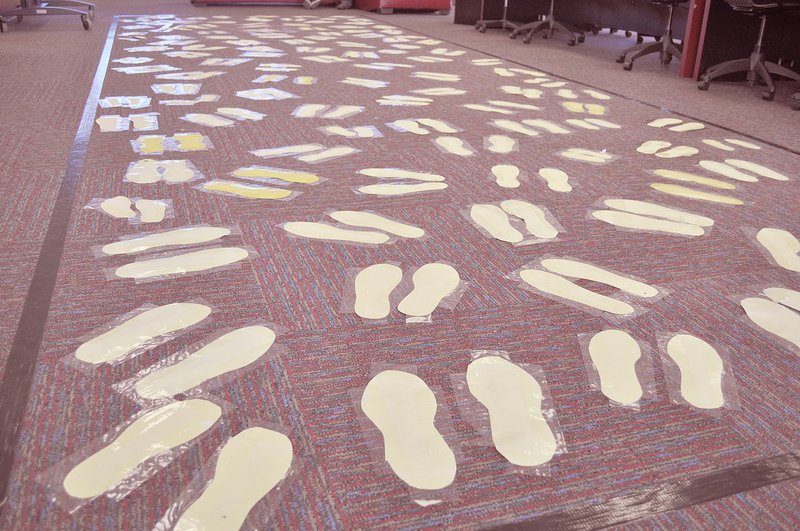The McDonald County High School library is hosting a World War II museum with books available to check out at almost every exhibit.
Librarian Jill Williams provided a tour of the museum, which begins with an assortment of World War II memorabilia brought by faculty members. Williams brought a shoe shine kit and a hula doll that belonged to her grandfather. Also part of the collection are an Army helmet and a passport with a Nazi stamp.
Next is a group of photographs. Williams said the students were fascinated by one of the children in gas masks playing on a playground and another of the women saying goodbye to their sailors through the portals of a ship.
"Amazingly, the pictures have had a profound affect on the kids," she said, indicating a group of photos of children saying goodbye to their fathers as they go off to war.
Another photograph is of Queen Elizabeth II serving as a mechanic and driver during the war.
On the floor of the library is a taped-off area where Williams measured the size of a rail car and put 100 students in the area. There are paper footprints to mark where the students stood. The exhibit represents the Jews that were crammed into rail cars and taken to concentration camps during World War II.
Many different classes contributed to the museum. French classes did posters on the French resistance going on during the war. Art classes painted war images such as planes and soldiers.
"I sent an email out to all the teachers saying this is what's happening, and they just started bringing stuff. The kids did the work," Williams said.
There is an exhibit on the atomic bomb. Students made a mushroom cloud and posted research about the bombs. Little Boy was the name of the bomb dropped on Hiroshima, and Fat Man was the name of the bomb dropped on Nagasaki.
Most of the books were checked out at the exhibit on Dr. Josef Mengele, the infamous Nazi doctor who liked to do human experiments in concentration camps, especially on twins.
At another station, visitors can fold origami cranes. The book "Sadako and the Thousand Paper Cranes" is about a girl in Japan who got leukemia as a result of the bomb dropped on Hiroshima. It was believed that if you could fold 1,000 paper cranes, your wish would come true. The high school is folding 1,000 paper cranes to send to St. Jude's Children's Research Hospital in Memphis.
Another exhibit explores the two Japanese internment camps in Arkansas.
"They lost their homes, they lost their status. It didn't matter if they had a soldier serving in the U.S. Army. This has been one area where the kids were like, what?" Williams said.
Also highlighted in the museum is the role of women during the war. Williams noted women worked as pilots and spies.
"You always hear about the nurses and the Rosie the riveters," she said.
One wall is dedicated to the Pearl Harbor attack. There are pictures of the memorial and a list of the 1,500 who died in the attack.
Another exhibit is dedicated to German propaganda. The Germans created a board game that was rigged so that Germany could not lose, Williams explained. This was to teach German children that Germany could not be defeated. Another board game involved moving Jews out of a city. A third board game came with a Nazi armband.
Rationing and victory gardens were the subject of another exhibit.
"They had to ration canned foods, so that's why they started victory gardens," Williams said. Some foods, for example, meat, were rationed as late as 1954, the exhibit said.
Asked what she thought about the museum, Williams said, "I think it's incredible. I'm so proud of the kids for putting it all together. I'm proud of their response. I'm surprised they didn't know some of this stuff. I think it was a good way of pulling a lot of departments together and I think it's a good way of making history come alive for them."
General News on 11/23/2017
